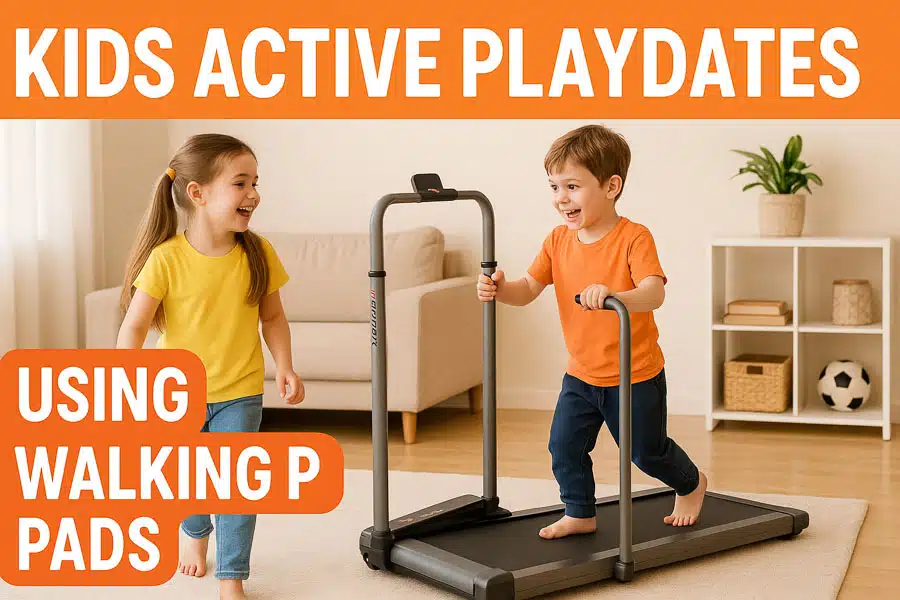Active playdates are a fantastic way to ensure children stay active while having fun with their peers. By incorporating tools like walking pads into these playdates, it becomes easier to motivate kids to stay on their feet and move around.
Walking pads can transform the typical playdate into an exciting, health-focused event that encourages both fun and exercise.

Children need movement every day to support their physical and mental growth. Whether through running games, dancing, or using equipment, these activities are vital.
Walking pads offer a unique and controlled environment for kids to enjoy walking exercises. This is especially helpful when the weather isn’t cooperating or space is limited.
The idea of combining walking pads with active playdates is all about blending exercise with creativity. This method not only ensures that children are getting the activity they need but also keeps them engaged and entertained.
With a little imagination, you can turn any ordinary playdate into a memorable and active session for kids.
Key Takeaways
- Active playdates boost children’s physical activity levels.
- Walking pads add a fun twist to traditional playtime.
- Organising engaging activities keeps kids moving and entertained.
The Importance of Active Play
Active play is a crucial part of a child’s development. It helps build physical strength, sharpens cognitive abilities, nurtures social skills, and boosts emotional health. In Ireland, active play is an integral part of parenting, providing opportunities for free play and outdoor experiences that contribute to a child’s holistic growth.
Physical and Cognitive Benefits
Active play encourages children to move, helping them build strong muscles and bones. Activities like running, jumping, and climbing not only improve physical health but also enhance coordination and balance.
Moreover, play stimulates brain activity, promoting better attention spans and problem-solving skills.
Engaging in varied active play can significantly enhance learning capacities. According to studies, children who are consistently active show improvements in memory and concentration.
The varied movements necessary in play foster a strong mind-body connection, essential for cognitive development. Active play in natural settings, such as parks and playgrounds, introduces them to diverse environments, further enriching their sensory experiences.
Social Skills and Emotional Development
Active playdates offer more than just physical exercise. They are golden opportunities for children to develop social skills. Playing with others requires communication, cooperation, and conflict resolution, all vital abilities for emotional and social growth.
Through play, children learn about sharing, empathy, and teamwork.
Outdoor play often brings challenges and successes that build resilience and self-confidence. It allows children to express emotions and practice self-regulation.
Witnessing their capabilities—whether they are climbing a tree or completing a group game—reinforces a positive self-image. This combination of social interaction and emotional learning is a fundamental aspect of their overall development, helping them grow into well-rounded individuals.
Equipment for Active Playdates
During active playdates, it’s important to use the right equipment to keep kids engaged and energetic. Walking pads, diverse playground equipment, and portable obstacle courses can all offer exciting ways to promote physical activity among children.
Walking Pads: Engaging Toddlers
Walking pads are a fantastic way to introduce toddlers to gentle exercise. They are compact and easy to store, making them ideal for homes with limited space.
With simple controls and an engaging LED display, walking pads can motivate children to walk a little each day. Many walking pads come with fun features to keep toddlers interested.
Using a walking pad during playdates can set a routine of active play. I’ve found that having a walking pad at home encourages kids to walk while listening to their favourite tunes.
This combination can turn a simple walk into an engaging activity, fostering a habit of exercise from an early age.
Playground Equipment: Beyond the Basics
Playground equipment offers a wealth of opportunities for physical activity. Beyond traditional swings and slides, newer options include climbing walls, rope bridges, and spinning toys.
These not only provide fun but also help develop balance and coordination.
Investing in a range of playground equipment at home invites endless adventures. During playdates, I notice children gravitating towards more challenging pieces, which encourages teamwork and boosts confidence as they explore and conquer new challenges.
These experiences are crucial for building social and physical skills from a young age.
Portable Obstacle Courses
Portable obstacle courses are perfect for transforming any space into an active adventure playground. These courses can include tunnels, cones, and hurdles, allowing for endless configurations.
They are lightweight and easy to set up, which means they can be brought out for any playdate without much hassle.
Creating an obstacle course is a great way to stimulate imagination and physical activity. I enjoy setting up courses that challenge speed and agility, allowing children to have fun while improving their fitness levels.
These courses can be tailored to fit both indoor and outdoor settings, making them versatile additions to active playdates.
Creative Ways to Encourage Movement
Encouraging movement in children can be both fun and educational. By incorporating creative activities, kids can stay active while exploring their interests in art, science, and nature.
Incorporating Art and Crafts
Involving art in physical activities can be a fantastic way to get children moving. I like to set up painting or colouring stations outdoors where kids can freely express themselves without worrying about making a mess indoors.
This not only gets them walking around but also sparks their creativity.
A large canvas or chalk on the pavement can encourage movement as children paint or draw with their whole bodies. Using large paintbrushes or water balloons filled with paint adds an element of physical activity and excitement.
This approach provides a sensory-rich experience, integrating both art and physical movement seamlessly.
Explorative Science Experiments
Science experiments can also be a catalyst for movement. By creating experiments that involve physical action, children can learn scientific concepts while staying active.
For instance, a simple experiment involving vinegar and baking soda can lead to creating a mini volcano. The excitement of seeing the volcanic reaction encourages kids to move around and adjust their experiment setup.
Another engaging activity is building a small rocket. Kids can help with each step, from assembling the rocket to launching it, which requires them to move about and be actively involved.
This not only teaches them about propulsion but also keeps them physically engaged. Incorporating interactive science into playtime can transform learning into an active adventure.
Nature Walks and Outdoor Adventures
Nature walks offer a perfect opportunity for children to explore and move. I often see kids develop a love for the outdoors through structured activities, like scavenger hunts.
Creating a list of items to find—such as specific leaves, rocks, or insects—keeps them interested and active.
Outdoor activities, like climbing or exploring a natural trail, add an element of adventure. Children can engage in physical challenges, enhancing their motor skills and coordination.
It’s important to ensure these activities are safe and accessible, enriching their understanding of nature while promoting a healthy lifestyle.
Encouragement and enthusiasm play a crucial role in getting children involved and excited about exploration and physical exercise.
Challenges in Promoting Active Play

When encouraging active play for children, several challenges can arise. These include finding suitable time and space for activities, dealing with helicopter parenting, and addressing safety concerns.
Finding Time and Space
One of the biggest challenges in promoting active play is finding adequate time and space. Many families live in urban areas with limited outdoor spaces, making it hard to find safe play areas.
In cities, parks may be crowded or far from home, requiring extra effort to visit regularly. Additionally, busy schedules with schoolwork and extracurricular activities can limit available time for play.
To tackle this, parents can prioritise short bursts of activity, even in small spaces like gardens or living rooms. Simple activities like dance breaks or mini obstacle courses can be fun and effective.
By remaining flexible and creative, families can discover pockets of time and place for children to engage in play.
Combatting Helicopter Parenting
Helicopter parenting can sometimes discourage active play. Parents might fear injuries or the unknown, limiting children’s freedom to explore and engage in physical activities. This style of parenting can lead to over-supervised or structured play, which may stifle creativity.
To promote a balanced approach, it’s important for me to gradually allow more independence while still keeping an eye on safety.
Establishing basic rules, such as staying within set boundaries or playing near home, can create a sense of security. Encouraging children to make their own choices and learn from minor mishaps helps develop confidence and decision-making skills.
Safety Concerns and Precautions
Safety is a significant worry when it comes to active play. Concerns around injuries or accidents can make parents hesitant to encourage outdoor activities.
Providing a safe environment can help address these worries. For instance, ensuring that playground equipment is well-maintained and age-appropriate can reduce risks.
Similarly, choosing safe locations like enclosed parks can offer peace of mind. Teaching children about road safety, stranger danger, and buddy systems can further alleviate concerns.
Age-Appropriate Activities for Active Playdates

When planning active playdates, it’s important to tailor activities to different age groups. This ensures that the play is both fun and beneficial. From simple crawling games for toddlers to structured play for pre-teens, these activities help keep children moving and engaged in ways that suit their developmental stages.
Activities for Toddlers
For toddlers, active play should involve both simple and fun activities. Crawling is one of the first ways toddlers explore movement, and it can be encouraged with games like “follow the leader.” Creating a small obstacle course in the living room with soft cushions and safe objects invites exploration.
Outdoor activities are equally important. A walk to the local park offers a change of scenery and new challenges. While there, simple games of tag or kicking a soft ball can keep toddlers entertained.
It’s also helpful to set up play dates that encourage social interaction and movement, providing a double benefit of social and physical development.
Engaging Primary School Children
For children in primary school, variety in play is key. They need activities that challenge their growing motor skills. An obstacle course set up in the garden with cones, hoops, and ropes can offer physical challenges. This not only enhances gross motor skills but also builds confidence as children accomplish small physical tasks.
Outdoor activities like hide and seek or hopscotch allow kids to burn off energy while having fun. Walking pads are a great addition, offering indoor activity options.
They can mimic nature walks or routes around familiar places, keeping children active and imaginative. Team games such as kickball or relay races can boost cooperative play, encouraging teamwork and communication.
Pre-Teens and Structured Play
Pre-teens benefit from more structured play that adds an element of challenge and strategy. At this age, children enjoy organised sports, which can be part of a playdate.
Games like football, basketball, or netball not only engage them physically but also teach them teamwork and sportsmanship.
Indoor activities can include using a walking pad to simulate hiking trails or scenic walks, which can be coordinated with a virtual setting on a screen. Creating fun challenges that require problem-solving, like a scavenger hunt with clues, stimulates both physical and mental engagement.
Such balanced activities ensure pre-teens remain enthusiastic yet challenged during playdates.
Planning and Preparation
Organising an active playdate begins with choosing a convenient time and location. I prefer hosting in parks that are walking distance from our home. This approach encourages movement before playtime even starts.
Next, I draft a guest list, keeping the group small to ensure everyone is involved. Invitations can be sent digitally or as fun, themed paper invites. I also confirm any allergies or special needs in advance.
Finally, I gather necessary supplies. For outdoor play, this includes balls, frisbees, and cones. Meanwhile, indoor play requires creativity, so think about setting up obstacle courses using furniture and cushions.
Setting the Scene for Fun and Movement
When hosting, creating a welcoming and energetic environment is key. I decorate the space with colourful banners and balloons to excite kids upon arrival. Music adds an upbeat vibe, motivating them to jump and dance.
I set up activity stations to foster continuous movement and prevent boredom. For instance, I create a mini sports area with goals for football, a craft table for quieter moments, and a space for free play where imagination thrives.
It’s important to encourage kids to explore all the areas. I use gentle guidance to keep them engaged with different activities at their own pace. Positioning play areas creatively within sight allows for easy supervision.
Active Playdate Agenda and Flow
To ensure the playdate runs smoothly, I organise a flow that balances structured and free play. I start with a warm-up activity like a group game or a short walk in the park. It helps the kids to settle in and get comfortable.
A planned timetable includes set times for each activity, with transitions that maintain momentum without causing chaos. For example, after a round of tag, we might cool down with a craft session.
I always keep a list of backup activities ready in case something doesn’t go as planned. Snack and rest breaks are essential, providing kids with the energy they need for continuous active play. Snacks like sliced fruits and water keep everyone hydrated and refreshed.
Tips for Parents and Guardians
Bringing in walking pads to playdates can be a great way for kids to be active. Parents and guardians can use some effective methods to make sure their kids make the most of this time.
Encouraging Participation
To get children excited, I find that framing activities as adventurous or game-like works wonders. Simple competitions or setting fun goals can spark interest. By turning everyday walks into treasure hunts or races, kids are more likely to join in.
It’s crucial to respect each child’s comfort level and to offer smaller challenges for those who might need a gentler start.
Kids are generally curious and eager to explore. Letting them choose the music or theme for their walking session can empower them. By giving them some control, you’re more likely to keep them engaged and interested in the walking pad activity.
Monitoring and Adapting Activities
Watching children as they use walking pads is essential both for safety and enjoyment. I keep an eye on their tiredness levels and adjust activities accordingly. If they start looking bored or tired, a change of pace or a break might be necessary.
Introducing new games or play styles ensures they remain lively and engaged.
It’s also vital to adapt activities to suit different age groups and abilities. For younger children, breaking down activities into smaller, manageable steps helps them stay focused and enjoy the session. Meanwhile, older kids might enjoy more complex games or challenges, allowing them to push their limits safely and constructively.
Positive Reinforcement and Feedback
Praising children for their efforts keeps them motivated. I offer specific compliments, like acknowledging their enthusiasm or improvement. Recognition of achievements, no matter how small, helps boost their confidence and keeps them excited for the next playdate. Verbal encouragement, high fives, or small rewards can go a long way.
I find that constructive feedback is essential when children try new activities, fostering a positive environment. It’s important to be supportive rather than critical, guiding them through difficulties with a reassuring attitude. This approach helps children associate active play with success and enjoyment, leading to healthier habits over time.
Conclusion
Incorporating active play into children’s routines is crucial for their physical and emotional well-being. Walking pads can be a valuable addition, offering a way for kids to stay active even in limited spaces or poor weather. Encouraging regular playtime with devices like these can help children develop healthy habits.
I find that introducing walking pads during playdates makes physical activity fun and engaging. It provides an opportunity for kids to interact with their peers while staying active. This blend of social interaction and physical exercise is beneficial for developing teamwork and communication skills.
In Ireland, where weather can often be unpredictable, walking pads offer a reliable indoor option. Parents can encourage children to set small milestones, making physical activity an exciting challenge rather than a chore. These pads are an excellent tool for ensuring consistent movement, even when playing indoors.
Offering a variety of activities during playdates ensures that kids remain interested and motivated. Combining walking pads with other games or activities can create a balanced and enjoyable environment. Keeping kids active doesn’t have to be complicated—it can be as simple as integrating a walking pad into their playtime routine.
Frequently Asked Questions
Active playdates can be a fun way to ensure children stay physically active. Using tools like walking pads, these sessions are both engaging and beneficial. Various activities can suit different age groups, ensuring safety and enjoyment for all.
What are the benefits of physical activity for children?
Physical activity helps children build strong bones, muscles, and joints. It improves their cardiovascular health and boosts mood, reducing the risk of mental health issues. Regular activity enhances concentration and fosters better academic performance.
How can I keep my children entertained during active playdates?
Incorporate games and challenges to make playdates exciting. Include activities like scavenger hunts or obstacle courses. This keeps children engaged and motivated while they follow the routine to get fit.
At what age is it appropriate for children to start using walking pads safely?
Children can begin using walking pads when they have good balance and coordination. Usually, this is at around 8 years old. Ensuring adult supervision and setting a comfortable speed are key to preventing any accidents.
What are some examples of vigorous play activities suitable for children?
Activities like tag, relay races, and skipping ropes are vigorous yet enjoyable. Dancing to upbeat music or playing sports like football are also great ways to burn energy and keep kids active.
Can walking pads improve the quality of active family activities?
Walking pads allow families to engage in walking indoors. This is especially beneficial during bad weather. They can walk while having conversations or even watching educational programs, making physical activity part of their daily routine.
What are the Health and Safety Executive (HSE) guidelines regarding screen time for children?
The HSE suggests that children aged 3 to 5 should have no more than 1 hour of screen time per day. For older children, it’s advisable to ensure screen time doesn’t replace sleep, physical activity, or real-life social interaction.




